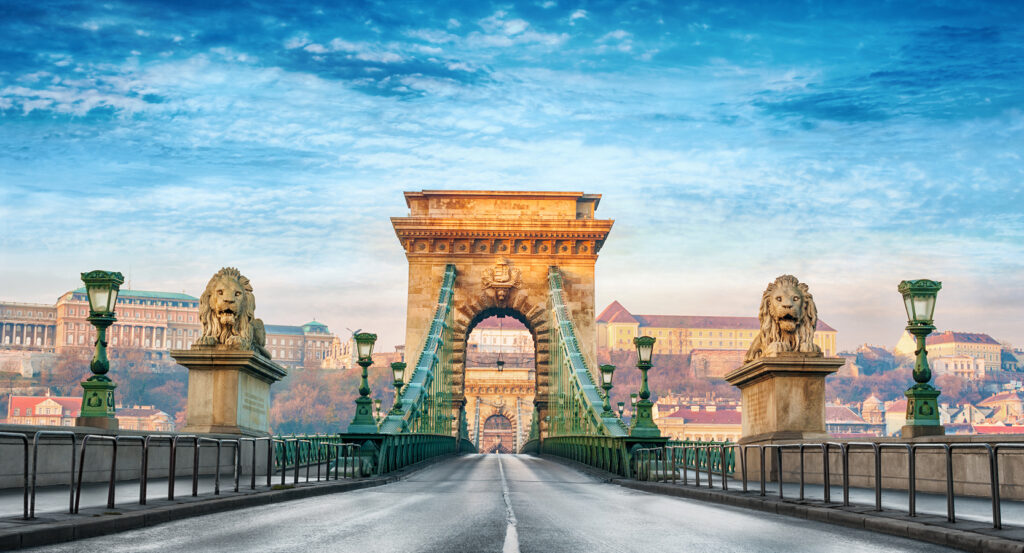
Why you should experience the Széchenyi Chain Bridge in Budapest.
The Széchenyi Chain Bridge isn’t just a crossing over the Danube, it’s the heartbeat of Budapest itself.
Stretching elegantly between Buda and Pest, this iconic suspension bridge embodies the union of two once-separate cities, now bound together by stone, steel, and spirit. Completed in 1849, it was the first permanent bridge across the Danube in Hungary, and its completion signaled a new chapter for the nation, one of innovation, unity, and progress. Designed by the English engineer William Tierney Clark and built under the supervision of the Scottish engineer Adam Clark, the bridge remains one of the most striking achievements of 19th-century engineering. Its twin arches and massive chains gleam in the sunlight, while its stately stone lions guard each entrance as if protecting the soul of the city. Walking across the bridge, you feel suspended not only between two riverbanks but between eras, the grandeur of imperial Europe reflected in the waters below and the vibrant rhythm of modern Budapest pulsing all around. From this vantage point, the city unfolds in cinematic beauty: the domed Hungarian Parliament rising on one side, Buda Castle crowning the opposite hill, and the Danube flowing quietly beneath it all. Every step on the Chain Bridge feels like stepping deeper into the story of Hungary, one defined by resilience, grace, and the eternal meeting of history and horizon.
What you didn’t know about the Széchenyi Chain Bridge.
Behind its timeless silhouette lies a saga of courage, genius, and rebirth.
The bridge owes its existence to Count István Széchenyi, a visionary often called “the Greatest Hungarian.” Legend has it that when winter ice prevented him from crossing the Danube to attend his father’s funeral, Széchenyi vowed that no one should ever again be divided by the river. What followed was one of the most ambitious engineering projects of its century. Built with precision and elegance, the bridge stood as a triumph of technology and national pride, the first of its kind in Central Europe. When it opened, it was hailed as one of the world’s engineering wonders, symbolizing Hungary’s entrance into modernity. But its history was not without heartbreak. During World War II, retreating German troops destroyed the bridge, leaving only the stone towers standing in the icy river mist. Yet from that devastation rose a symbol of rebirth, painstakingly reconstructed and reopened in 1949, exactly one hundred years after its original inauguration. Today, the Széchenyi Chain Bridge remains a living emblem of endurance. Its architectural elegance continues to inspire poets, painters, and travelers alike, while its glowing illumination each night casts a golden reflection across the Danube, a shimmering thread that unites the city’s soul. Even its details hold quiet marvels: the lions at each end, often thought to be identical, are subtly distinct, each hand-sculpted with its own expression. The bridge’s design, revolutionary in its day, influenced countless structures across Europe, yet none captured the same harmony between function and poetry. Every chain link, every carved stone seems to whisper Széchenyi’s original dream, that Budapest would forever be one city, undivided by time or tide.
How to fold the Széchenyi Chain Bridge into your trip.
Crossing the Chain Bridge isn’t just sightseeing, it’s communion with the spirit of Budapest.
Start your walk on the Pest side near Széchenyi István Square, where the bridge’s ironwork glimmers beneath the sky. As you step onto the pathway, feel the hum of life below, the murmur of the Danube, the echo of footsteps, the distant chime of church bells. The pedestrian lanes make it easy to stroll slowly and savor the moment, each step offering a postcard view of the city’s elegance. Midway across, stop to gaze at the water, boats drifting like fireflies, the Parliament glowing on one side, and the royal heights of Buda on the other. From here, the city feels infinite, its light and energy reflected in the rippling surface of the river. On the Buda side, the stone lions watch over your arrival as Castle Hill looms above, climb or take the funicular for a panoramic view that will leave you breathless. Visit Fisherman’s Bastion or Matthias Church nearby to see the bridge from above, especially at sunset when the skyline blushes gold and rose. For another unforgettable perspective, take a river cruise after dusk, the bridge illuminated like a jeweled necklace across the Danube, its reflection doubling the beauty of the scene. In winter, the air is crisp and the bridge shimmers with frost; in summer, it thrums with laughter and music from the embankments below. End your walk with dinner or dessert along the river promenade, perhaps langos or a glass of Tokaji, as you watch the lights of the bridge glitter against the night. The Széchenyi Chain Bridge is more than architecture, it’s the living soul of Budapest, a masterpiece of endurance and artistry that continues to bind the city, its people, and its dreams in perfect harmony.
Hear it from the Foresyte community.
The lions are the real stars. Just standing there like they’ve been watching Budapest drama for centuries. Kinda made me stop and stare.
Where meaningful travel begins.
Start your journey with Foresyte, where the planning is part of the magic.
Discover the experiences that matter most.






































































































